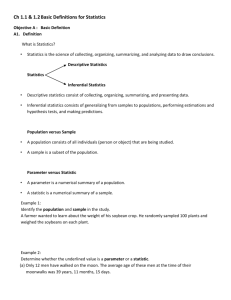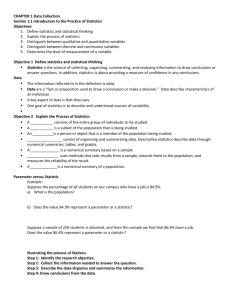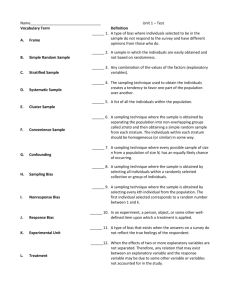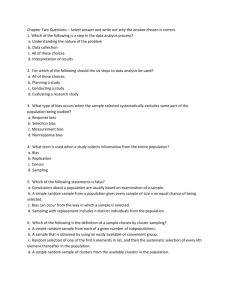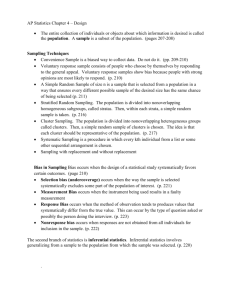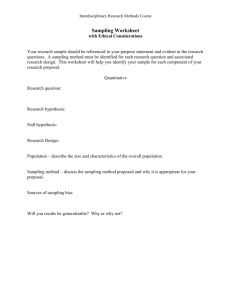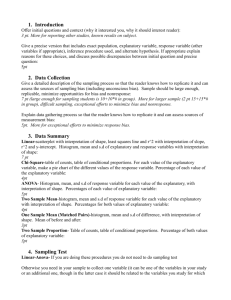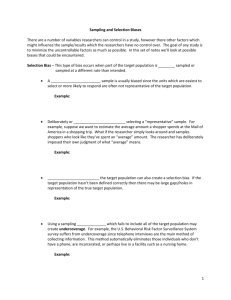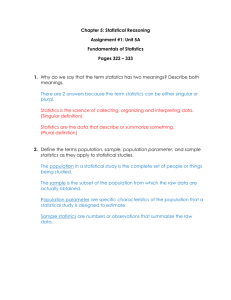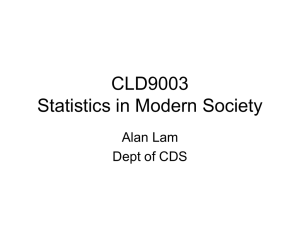CHAPTER 1 Data Collection Section 1.1 Introduction to the Practice
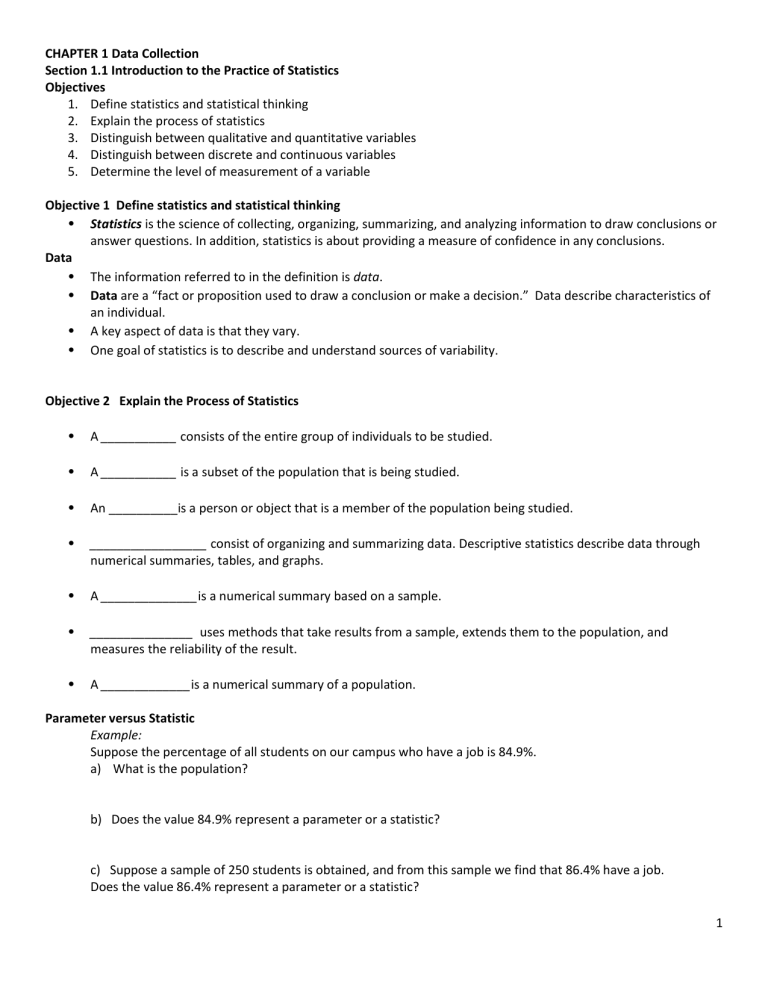
CHAPTER 1 Data Collection
Section 1.1 Introduction to the Practice of Statistics
Objectives
1.
Define statistics and statistical thinking
2.
Explain the process of statistics
3.
Distinguish between qualitative and quantitative variables
4.
Distinguish between discrete and continuous variables
5.
Determine the level of measurement of a variable
Objective 1 Define statistics and statistical thinking
•
Statistics is the science of collecting, organizing, summarizing, and analyzing information to draw conclusions or answer questions. In addition, statistics is about providing a measure of confidence in any conclusions.
Data
•
The information referred to in the definition is data.
•
Data are a “fact or proposition used to draw a conclusion or make a decision.” Data describe characteristics of an individual.
•
A key aspect of data is that they vary.
•
One goal of statistics is to describe and understand sources of variability.
Objective 2 Explain the Process of Statistics
•
A ___________ consists of the entire group of individuals to be studied.
•
A ___________ is a subset of the population that is being studied.
•
An __________is a person or object that is a member of the population being studied.
•
_________________ consist of organizing and summarizing data. Descriptive statistics describe data through numerical summaries, tables, and graphs.
•
A ______________is a numerical summary based on a sample.
•
_______________ uses methods that take results from a sample, extends them to the population, and measures the reliability of the result.
•
A _____________is a numerical summary of a population.
Parameter versus Statistic
Example:
Suppose the percentage of all students on our campus who have a job is 84.9%. a) What is the population? b) Does the value 84.9% represent a parameter or a statistic? c) Suppose a sample of 250 students is obtained, and from this sample we find that 86.4% have a job.
Does the value 86.4% represent a parameter or a statistic?
1
Illustrating the process of Statisics
Step 1: Identify the research objective.
Step 2: Collect the information needed to answer the question.
Step 3: Describe the data Organize and summarize the information.
Step 4: Draw conclusions from the data.
Objective 3 Distinguish between Qualitative and Quantitative Variables
•
____________ is the characteristics of the individuals within the population.
•
Key Point: Variables vary. Consider the variable height. If all individuals had the same height, then obtaining the height of one individual would be sufficient in knowing the heights of all individuals. Of course, this is not the case. As researchers, we wish to identify the factors that influence variability.
Variables and Types of Data
Variables can be classified as _______________________ or _________________________.
•
___________________variables allow for classification of individuals based on some attribute or characteristic.
___________________variables provide numerical measures of individuals. Arithmetic operations such as addition and subtraction can be performed on the values of the quantitative variable and provide meaningful results.
Objective 4 Distinguish between Discrete and Continuous Variables
Quantitative variables can be further classified into two groups.
•
A _____________variable is a quantitative variable that has either a finite number of possible values or a countable number of possible values. The term “countable” means the values result from counting such as 0, 1,
2, 3, and so on. (e.g. # of books, # of desks)
•
A_____________ variable is a quantitative variable that has an infinite number of possible values it can take on and can be measured to any desired level of accuracy.
Classification of Variables
Example:
Classify each variable as qualitative or quantitative. If the variable is quantitative, further classify it as discrete or continuous. a) The number of heads obtained after flipping a coin five times. b) Weights of new born babies in a hospital c) Eye colors of students in Math 227
2
Objective 5 Determine the Level of Measurement of a Variable
•
Variables can also be classified by how they are categorized, counted, or measured.
•
The level of measurement of the data is useful in deciding what procedure to take to apply statistics to real problems.
Four common types of measurement scales are used to classify variables:
•
______________—the values of the variable name, label, or categorize. In addition, the naming scheme does not allow for the values of the variable to be arranged in a ranked, or specific, order.
•
_______________—it has the properties of the nominal level of measurement and the naming scheme allows for the values of the variable to be arranged in a ranked, or specific, order.
•
_______________—it has the properties of the ordinal level of measurement and the differences in the values of the variable have meaning. A value of zero in the interval level of measurement does not mean the absence of the quantity. Arithmetic operations such as addition and subtraction can be performed on values of the variable.
•
_______________—it has the properties of the interval level of measurement and the ratios of the values of the variable have meaning. A value of zero in the ratio level of measurement means the absence of the quantity.
Arithmetic operations such as multiplication and division can be performed on the values of the variable.
Example:
Classify each as nominal-level, ordinal-level, interval-level, or ratio level data. a) Sizes of cars b) Nationality of each student c) IQ of each student d) Weight
Section 1.2 Observational Studies Versus Designed Experiments
Objective
1.
Distinguish between an observational study and an experiment
Objective 1 Distinguish between an Observational Study and an Experiment
•
An ____________________ measures the value of the response variable without attempting to influence the value of either the response or explanatory variables. That is, in an observational study, the researcher observes the behavior of the individuals in the study without trying to influence the outcome of the study.
•
If a researcher assigns the individuals in a study to a certain group, intentionally changes the value of the explanatory variable, and then records the value of the response variable for each group, the researcher is conducting a _______________________
3
Example: Cellular Phones and Brain Tumors (textbook- page 15)
In both studies, the goal of the research was to determine if radio frequencies from cell phones increase the risk of contracting brain tumors. Whether or not brain cancer was contracted is the response variable (dependent
variable). The level of cell phone usage is the explanatory variable (independent variable).
In research, we wish to determine how varying the amount of an explanatory variable affects the value of a
response variable.
_________________in a study occurs when the effects of two or more explanatory variables are not separated.
Therefore, any relation that may exist between an explanatory (independent) variable and the response
(dependent) variable may be due to some other variable or variables not accounted for in the study.
A _______________ is an explanatory variable that was not considered in a study, but that affect the value of the response variable in the study. In addition, lurking variables are typically related to any explanatory variables considered in the study.
Example:
Identify the explanatory variable and the response variable for the following studies. a) Rats with cancer are divided into two groups. One group receives 5 mg of a medication that
is used to fight cancer, and the other receives 10 mg. After 2 years, the spread of the cancer
is measured. b) A researcher wants to determine whether young couples who marry are more likely to gain
weight than those who stay single.
A census is a list of all individuals in a population along with certain characteristics of each individual.
Section 1.3 Simple Random Sampling
Objective
1. Obtain a Simple Random Sample
Objective 1 Random sampling
•
A sample of size n from a population of size N is obtained through simple random sampling if every possible sample of size n has an equally likely chance of occurring. The sample is then called a simple random sample.
Example: Illustrating Simple Random Sampling
Suppose a study group of consists of 5 students:
Bob, Patricia, Mike, Jan, and Maria
2 of the students must go to the board to demonstrate a homework problem.
List all possible samples of size 2 (without replacement).
4
Section 1.4 Other Effective Sampling Methods
Objectives
1. Obtain a Stratified Sample
2. Obtain a Systematic Sample
3. Obtain a Cluster Sample
A _________________ is one obtained by separating the population into homogeneous, non-overlapping groups called strata, and then obtaining a simple random sample from each stratum. The individuals within each stratum should be homogeneous (or similar) in some way.
A _________________ is obtained by selecting every k th individual from the population. The first individual selected is a random number between 1 and k.
A ___________________ is obtained by selecting all individuals within a randomly selected collection or group of individuals.
Section 1.5 Bias in Sampling
Objectives
1. Explain the Sources of Bias in Sampling
Sources of Bias in Sampling
•
If the results of the sample are not representative of the population, then the sample has bias.
Three Sources of Bias
1. Sampling Bias – occurs when the technique used to obtain the individuals to be in the sample tends to favor one part of the population over another.
2. Nonresponse Bias – exists when individuals selected to be in the sample who do not respond to the survey have different opinions from those who do.
3. Response Bias – exists when the answers on a survey do not reflect the true feelings of the respondent.
Types of Response Bias: 1) Interviewer error; 2) Misrepresented answers; 3) Words used in survey
question; 4) Order of the questions or words within the question.
5
